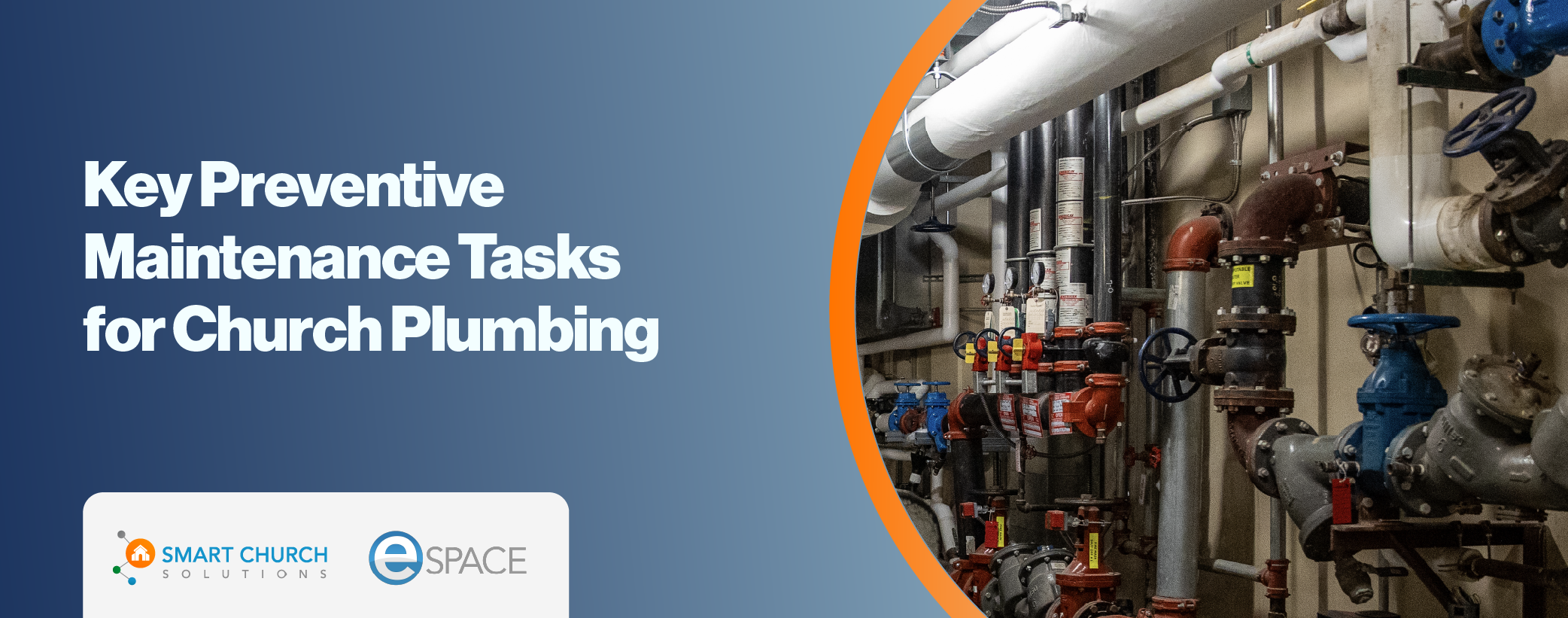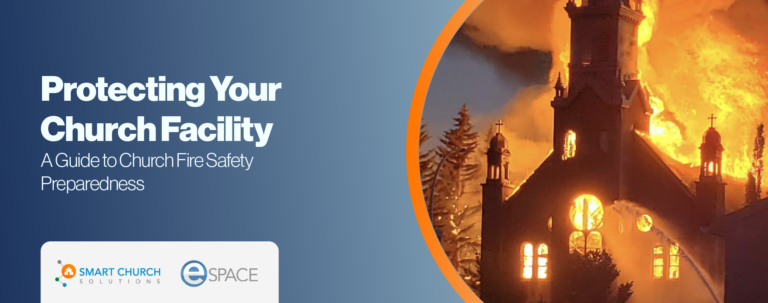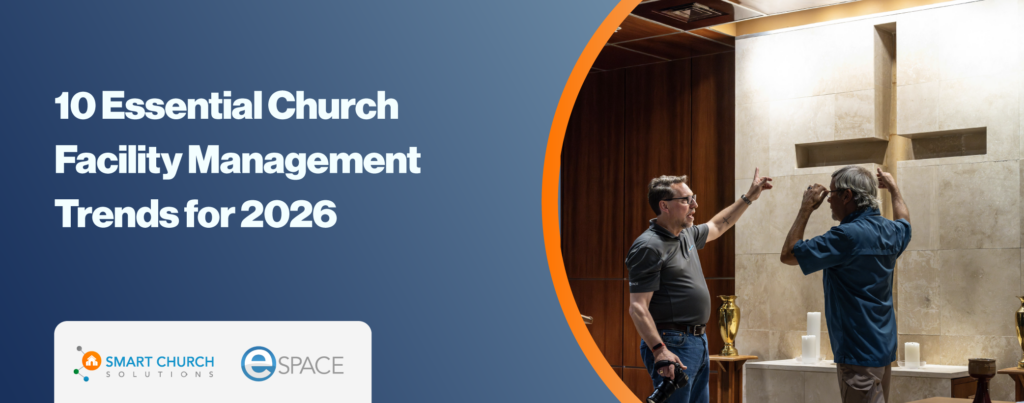When people think about church maintenance, plumbing probably isn’t the first thing that comes to mind. Yet, behind the scenes, your plumbing system plays a crucial role in maintaining a safe, clean, and welcoming environment for your congregation and guests. From restrooms and kitchens to baptistries and water fountains, a properly maintained plumbing system ensures that your church operates smoothly week after week.
Neglecting routine plumbing maintenance can lead to costly repairs, water damage, and even health hazards — all of which can disrupt ministry activities and strain your budget. The good news? Many plumbing issues are preventable with a little proactive care.
In this post, we’ll walk through essential preventive maintenance tasks every Facility Steward should implement to protect your church’s plumbing system, avoid unexpected emergencies, and extend the life of your infrastructure.
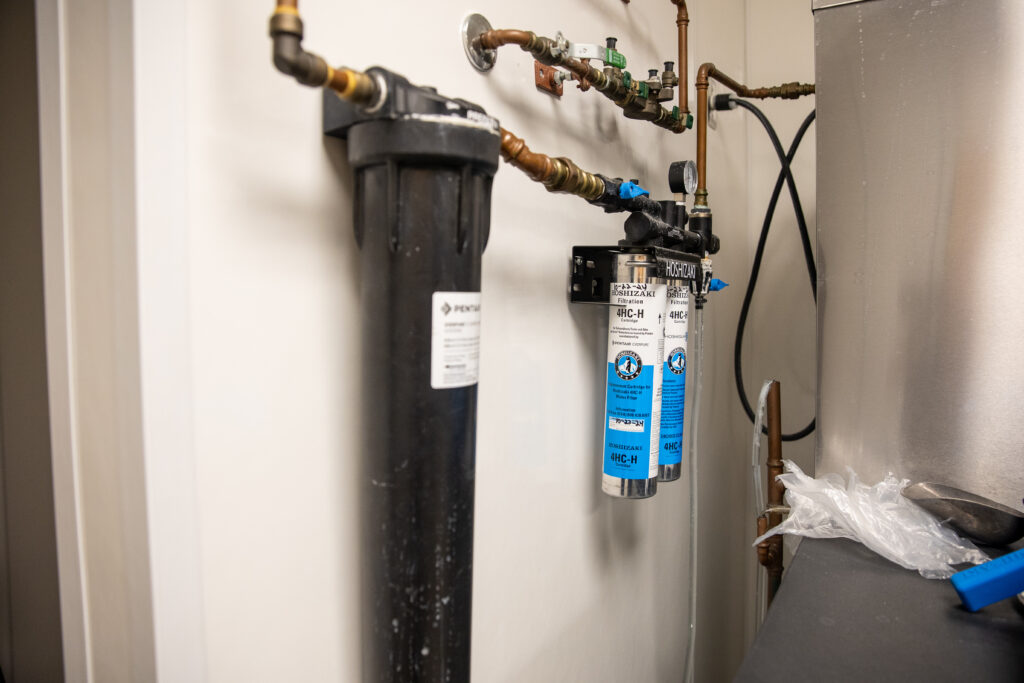
1. Regularly Inspect for Leaks
Even the smallest water leak can quietly waste gallons of water, damage building materials, and promote mold growth if it goes unnoticed. That’s why regular inspections are one of the simplest — yet most important — preventive maintenance tasks for your church facility. Make it a habit to routinely check:
- Faucets in restrooms, kitchens, and utility sinks for drips.
- Toilets that continue to run after flushing, which can waste hundreds of gallons a day.
- Water stains, dampness, or mold under sinks, around toilets, near walls, and in mechanical rooms.
- Pipes and connections under sinks and in accessible plumbing areas for visible leaks or corrosion.
Address leaks promptly to avoid water waste, higher utility bills, and costly structural damage. Remember — a $2 washer today could prevent a $2,000 repair tomorrow.
2. Check Water Pressure Levels
Water pressure that’s too high might seem like a small concern, but over time, it puts unnecessary strain on your pipes, fixtures, and appliances, increasing the risk of leaks, worn-out fittings, and even burst pipes. To keep your system healthy:
- Use a water pressure gauge (available at most hardware stores) to check your building’s pressure at a hose bib or faucet.
- The ideal water pressure range is between 40 and 60 psi. Anything significantly higher can cause long-term damage.
- If your readings are too high, have a licensed plumber install or adjust a pressure-reducing valve (PRV) to bring it within a safe range.
Managing water pressure is one of the easiest ways to extend the life of your plumbing system and avoid unexpected repairs down the road.
3. Test and Maintain Water Heaters
Your church’s water heater quietly serves a vital role — providing hot water for restrooms, kitchens, cleaning, and baptistries. Like any equipment, it needs regular attention to perform reliably and efficiently.. Routine maintenance includes:
- Flushing the tank every 6-12 months to remove sediment buildup.
- Checking the temperature setting (120°F is ideal for safety and efficiency).
- Inspecting for rust, leaks, or corrosion on the tank and fittings.
- Testing the pressure relief valve to ensure it functions properly.
Regular maintenance extends the life of the water heater and prevents unexpected failures.
4. Inspect Toilets and Urinals for Proper Functioning
Church restrooms see a lot of foot traffic, and even minor plumbing issues can quickly become costly headaches if ignored. Routine inspections help catch problems early and keep facilities clean, efficient, and guest-friendly. During your regular walkthroughs:
- Check for silent leaks by adding a few drops of food coloring to the toilet tank. If color appears in the bowl without flushing, it’s time to replace the flapper valve.
- Ensure each fixture flushes properly and clears the bowl or urinal completely. Weak or incomplete flushing can lead to clogs and increased water waste.
- Look for water pooling around the base of toilets, which often indicates a failing wax ring — a simple repair that prevents costly water damage.
- Test automatic flush sensors (if installed) to confirm they activate consistently and don’t waste water through misfires or delayed flushes.
Keep in mind: a single running toilet can waste up to 200 gallons of water per day, making this one of the most important, cost-saving inspections on your list.
5. Maintain Floor Drains and Sewer Lines
Floor drains might be out of sight, but they should never be out of mind. Found in kitchens, restrooms, utility rooms, and mechanical areas, these drains play a crucial role in protecting your church from water damage and unpleasant odors.
To keep them working properly:
- Pour water into floor drains regularly to maintain the trap seal and prevent sewer gas from entering the building.
- Schedule an annual drain cleaning for kitchen, restroom, and utility drains to clear grease, soap, and debris buildup.
- Monitor for slow drains, which often signal a developing clog. Address these early before they cause a complete blockage.
- Have sewer lines inspected with a camera every few years, especially in older facilities with aging pipes. This helps identify root intrusion, corrosion, or other hidden issues before they turn into expensive problems.
A blocked drain or sewer backup isn’t just inconvenient; it can lead to costly repairs and operational disruptions. Regular maintenance is your best defense.
6. Winterize Plumbing in Cold Climates
If your church is in a region that experiences freezing temperatures, take these steps to prevent pipe bursts:
- Insulate exposed pipes in attics, crawl spaces, and exterior walls.
- Drain outdoor water lines and shut off irrigation systems before winter.
- Keep faucets dripping during extreme cold to prevent freezing.
- Ensure heating is maintained in areas with plumbing to prevent freezing.
Burst pipes are one of the most expensive winter-related facility disasters. Take preventive action before the cold sets in.
7. Clean and Maintain Water Fixtures
From kitchen sinks to drinking fountains, your church’s water fixtures need regular care to stay clean, functional, and efficient. Over time, mineral deposits and debris can build up, affecting water flow and quality. Include these simple tasks in your maintenance routine:
- Remove hard water deposits from faucets, showerheads, and drinking fountains by soaking them in vinegar or using a descaling solution.
- Inspect and clean aerators on sinks and faucets every few months to clear out mineral buildup and debris that can restrict water flow.
- Test drinking fountains regularly to ensure proper water flow, cleanliness, and that no leaks are present.
- Check automatic flush valves and sensor-activated faucets to confirm they’re working properly, and replace batteries as needed to avoid failures or water waste.
Keeping fixtures clean improves water quality and extends their lifespan.
8. Establish a Plumbing Maintenance Schedule
Many of these tasks should be performed on a regular basis. Here’s a suggested schedule:
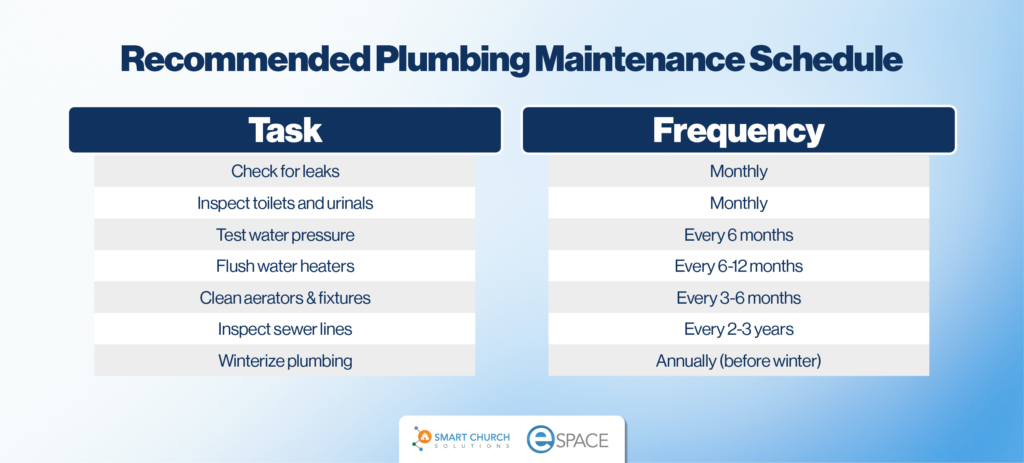
Use a facility management tool like eSPACE to track maintenance tasks and set automated reminders.
Facility Stewardship Is Ministry
Plumbing maintenance might not be the most exciting part of church management, but it’s an essential part of stewarding God’s house well. A little preventive care goes a long way in keeping your facility safe, functional, and cost-efficient.
At Smart Church Solutions, we help churches take a proactive approach to facility management with tools like eSPACE, which can help track maintenance schedules, work orders, and inspections.
Want to ensure your church’s plumbing stays in top shape? Let’s talk!


